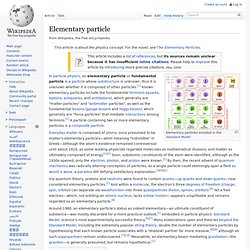

Matter Particle Fermions. Fermion. Antisymmetric wavefunction for a (fermionic) 2-particle state in an infinite square well potential.

In particle physics, a fermion is a particle that follows Fermi–Dirac statistics. These particles obey the Pauli exclusion principle. Fermions include all quarks and leptons, as well as all composite particles made of an odd number of these, such as all baryons and many atoms and nuclei. Elementary particle. In particle physics, an elementary particle or fundamental particle is a particle whose substructure is unknown, thus it is unknown whether it is composed of other particles.[1] Known elementary particles include the fundamental fermions (quarks, leptons, antiquarks, and antileptons), which generally are "matter particles" and "antimatter particles", as well as the fundamental bosons (gauge bosons and Higgs boson), which generally are "force particles" that mediate interactions among fermions.[1] A particle containing two or more elementary particles is a composite particle.

Overview[edit] An overview of the various families of elementary and composite particles, and the theories describing their interactions. List of particles. This is a list of the different types of particles found or believed to exist in the whole of the universe.

For individual lists of the different particles, see the individual pages given below. Elementary particles[edit] Fermions[edit] Fermions are one of the two fundamental classes of particles, the other being bosons. Fermion particles are described by Fermi–Dirac statistics and have quantum numbers described by the Pauli exclusion principle.